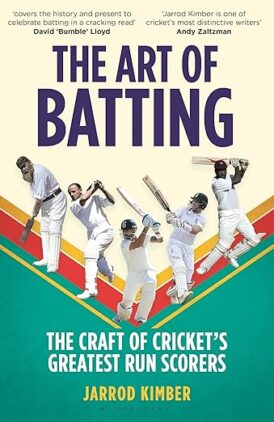The Art of Batting
Martin Chandler |Published: 2025
Pages: 273
Author: Kimber, Jarrod
Publisher: Bloomsbury
Rating: 4 stars

I will start of on this occasion with a word of warning. This one is a tough read, and not a book to pick up when you only have a few minutes to spare. That, I hasten to add, is not in any way intended as a criticism but, as the author’s name should have put me on notice of, this is not like any cricket book that I have read before. But the concentration you have to put into reading The Art of Batting is amply rewarded. I defy anyone not to enjoy this book, or to close it without their knowledge of the game being greatly enhanced.
The sub-title is The Craft of Cricket’s Greatest Runscorers, and it rather threw me initially. Ordinarily I would have assumed that the book would amount to something like a collection of short biographies on the game’s greatest batsman. That I did not make that assumption in this case was because I did not expect Jarrod Kimber to write anything that conventional. In that at least I was correct – he doesn’t.
The other possibility that occurred to me is that the book would be essentially some sort of instructional treatise. On reflection that thought was marginally closer to the mark, and if I were a good deal younger and still played the game I suspect that some of the concepts examined in the book might well have assisted me. But this certainly isn’t a ‘how to play cricket’ type of book.
Kimber does however examine batting technique, element by element in a way that it had never really occurred to me to do before. He sucked me in at the start by briefly going right back to the nineteenth century. I certainly hadn’t expected to read the names of Fuller Pilch, Alfred Mynn and Nicholas Felix, but they all get a mention in dispatches. The introduction dwells longest on the deeds of WG Grace. I have long since realised that Kimber has a thorough knowledge of the history of cricket, but his lauding of Grace’s skills won me over at the outset and will, I have no doubt, do the same for the rest of us for whom the only thing that really gets us our juices flowing is cricket played with a red ball.
The various chapter headings are short and to the point, Evolution, Eyes, Rapid, Testless and High Front Elbow to name the first five of fifteen. There are plenty of contributions from great players to go with Kimber’s store of knowledge, Rahul Dravid on fast bowling being particularly illuminating. There are plenty of stats in the narrative as well and, after some years of being unconvinced by the need for such information, I do now understand exactly what you can do with a stat like Virat Kohl’s batting average outside India against bowling of greater speed than 87 miles per hour. The number concerned is an impressive 63.6.
In the course of those fifteen chapters Kimber looks at each of the issues that face the great batsmen and which, by extension, affect everyone who has ever picked up a cricket bat in earnest. The challenges faced by different types of bowling are examined, as as are the steps that batsmen can take to upset the rhythm of those who are seeking to bring about their downfall.
Two of the most thought provoking chapters, in the sense that I hadn’t previously given them any real thought, are the latter two in that list of five. High Front Elbow starts from The MCC Cricket Coaching Book of 1952 and highlights just how much technique has evolved/changed over the years since it was published. Testless looks at the not unrelated subject of the difficulties those players who never or seldom play red ball cricket have in honing their technique. Sadly the women’s game has many who are ‘victims’ through no fault of their own. The men referenced have, on the other hand, at least made the choice to concentrate on white ball cricket
And finally, as he is quite entitled to do having put in the hard yards of writing the book, Kimber gives us his ranking for the fifty best batsman of all time. No one will agree with him of course, but that isn’t really the point. In truth most of us will have to concede, based on the factors he takes into account, that if we let our heads rule our hearts his list makes perfect sense. That much conceded in such matters my heart has always ruled my head, so I’d still have Garry Sobers at number one, closely followed by Barry Richards who, incidentally, was interviewed by Kimber and whose thoughts on the issue of Motivation are, if not surprising to those of us who had the privilege of seeing the great man bat, are still illuminating.
The Art of Batting is certainly recommended. It is original, well written and impressively researched. As I say you have to have some free time to spend with the book to do it justice, but perhaps during breaks in play in the forthcoming series between India and England, during which at least some of the points that Kimber makes will be brought very sharply into focus.






Leave a comment